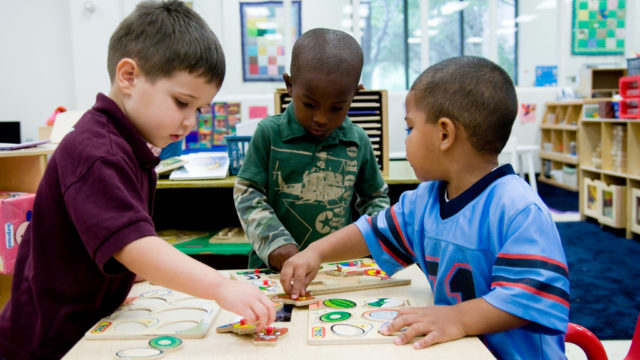This post was written by Donna Seymour, advocate and member of the St. Lawerence County Branch of AAUW-NYS as part of our PowHer the Vote 2017 campaign.
The Unites States tops the list as the most expensive place to raise children. Families will pay an average of $233,610 from birth through age 17 — or about $13,000 a year — according to government figures released in January. Families in urban areas in the Northeast, such as New York and Boston, were likely to pay even more — an average of $253,770, or roughly $14,000 a year — because of higher housing and child-care costs, according to a report by the Department of Agriculture. In fact, average child-care costs exceed the costs of in-state college tuition across the nation.
But rural families are also under the child care gun, and often with fewer choices, lower quality available care, and less in their paychecks to start with.
Here’s a case in point drawn from CAP’s “Mapping America’s Child Care Deserts“:
In Livingston County, New York, licensed child care is even sparser. The area is largely rural, with small towns and cities scattered among rolling hills and farmland. Many families only have one or two licensed child care providers from which to choose—if they are fortunate. In the Livingston County seat of Geneseo, a city of roughly 10,000 residents, there are only three licensed child care providers, with a combined capacity to care for fewer than 75 children. In areas such as these, parents are forced to make difficult decisions that might include finding unlicensed child care, leaving the workforce, or patching together a network of family and friends. For many families, these options are not ideal for children or for parents.
The cost of child care is a significant burden for parents who need it to support their families. The Center for American Progress looked at the data from the National Survey of Children’s Health found that just in 2016, nearly 2 million parents of children age 5 and younger had to quit a job, not take a job, or greatly change their job because of problems with child care.
According to a 2016 “Care Index” report by New America, a Washington, D.C. think tank, $9,589 per child, represents nearly a fifth of annual median household income and 85 percent of the yearly median cost of rent. And no state in the country had a system of care that scored well in each of three key areas of affordability, accessibility and quality, the report went on to say.
One of the hardest hit segments of society for child care are the more than 4.8 million undergraduate parents on campuses nationwide, who make up one quarter of all students and are a significant portion of those parents trying to better their economic situation by going back to school.
And the fact is, as data from the U.S. Department of Education’s National Center for Education Statistics shows, the vast majority of undergraduates are now classified as nontraditional, whether because they have dependents, are a single caregiver, delayed post-secondary enrollment, do not have a traditional high school diploma, are employed full-time, attend school part-time, or are independent of their parents for financial aid reasons. In all, 74% of all undergrads in 2011-12 had at least one nontraditional characteristic and about one-third had two or three.
As AAUW research from 2013 shows, child care on campus is a critical need for moms in school. The report “Women in Community Colleges: Access to Success” showed there are more than 4 million women attending two-year public institutions or community colleges, and more than 1 million of them are mothers. Compared with students without dependent children, student parents are more likely to drop out of school, and they most often cite caregiving responsibilities and limited financial resources as their reasons for leaving. According to the National Center for Education Statistics, less than half of the more than 1,000 community colleges in the United States offer on-campus child care for students.
Additionally, student parents rack up more student debt than most (25% more for a bachelor’s degree, on average), and drop out at higher rates than their child-free peers (only 27% of single student parents finish a bachelor’s degree within 6 years, versus about 56% of their child-free peers). For this group in particular, the cycle of enrolling and dropping out can compound an already vicious cycle of poverty, both for moms and eventually for their kids, too (research shows kids of parents without a degree don’t fare as well as the those of college grads).
And it is not just child care where America lags behind. According to the Organization for Economic Cooperation and Development, United States lags behind other industrialized nations when it comes to enrolling children in preschool. While the average enrollment for other “first world” countries is 73%, in the US, just 43 percent of 3-year-olds were enrolled in preschool.
Both before school day and after school day care is needed to help working families meet the challenges of both educating their school-age children and feeding and housing them. States and the federal government must step up to help fund these gaps in coverage. Tax credits are a useless tool for the vast majority of parents who don’t make enough to earn them.
In the modern world, America has to have a frank and open discussion about the cost, quality, accessibility, and supply of child care – and about the need for universal Pre-K. Policy makers can’t just leave child care and early education on the table when it comes to building a 21st century workforce and workplace.
This isn’t rocket science. Other nations have figured out the link between high quality, affordable and accessible child care and a strong economic prosperity for all. According to A Blueprint for Child Care Reform:
The United States can do better for the millions of families struggling with the high cost of child care. Prioritizing child care puts families first and helps children succeed in school and life. It’s an investment in our education system and our future workforce and is one the country cannot afford to ignore. This report outlines a progressive vision for child care reform that guarantees financial assistance on a sliding-scale basis for middle- and low-income families with children ages 12 or younger and children with disabilities up to age 18.
Below is a North Country Matters show I did with Blue Carreker, the Upstate Organizer for the Citizen Action of New York & Public Policy and Education Fund of New York, about the crises in child care in New York State. Lack of quality, affordable childcare is a drag on our economy. We discussed the gap between the needs and the available services and what can be done to bridge those gaps. (April 21, 2017)
This post originally appears on Donna Seymour’s blog and can be viewed here.


